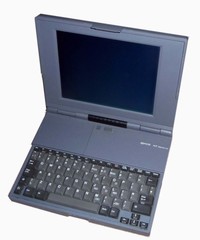|
The Apricot NT 386SX-25 is an AT compatible computer that combines the power and performance of a desktop 386SX system with the convenience and portability of a laptop. Offering advanced features such as intelligent power conservation, VGA video display, built-in 60MB hard disk, and Suspend/Resume function, the computer is designed to meet the needs of the most demanding professional users.
Standard Features
• A 25MHz 80386SX microprocessor that can be keyboard-switched to run at 6MHz if desired.
• A 60MB (Megabyte) removable hard-disk drive, formatted and operational when shipped.
• An internal, 1.44MB 3.5-in. floppy-disk drive for data transfer and storage.
• 2MB of internal RAM (Random Access Memory). This allows allocation of a maximum of 640KB (Kilobytes) of base memory. 384KB out of 1MB can be set aside as BIOS Shadow where BIOS code can be executed faster than in the slower EPROMs. The system default is "BIOS SHADOW ENABLED"
• Liquid Crystal Display, 640x480 resolution, supporting Monochrome (MDA), Color (CGA), EGA and VGA modes
• Color mapping: allows mapping of 2, 4, 8, 16 or 256 colors to a maximum of 64 gray shades.
• Built-in serial communication and parallel printer ports.
• An internal battery-backed clock/calender.
• A full-size 80-key keyboard. 12 function keys are arranged across the top row of the keyboard.
• LED panel that indicates when the Caps Lock, Num Lock and Scroll Lock are engaged. Panel also contains LED's that indicate : power on, stand-by, low battery, HDD/FDD access, and DC power.
• A rechargeable, removable primary battery enabling operation anywhere.
• Two expansion slots: an optional memory expansion card slot and a modem/auxiliary battery slot.
• An external CRT connector which supports an analog VGA monitor.
Our machine is in very nice condition and is complete with manual, power supply and cables was kindly donated by Ian Jones.
Manufacturer: Apricot
Date: January 1992
Comment on This Page
Other Systems Related To Apricot NT 386SX-25:
This exhibit has a reference ID of CH18430. Please quote this reference ID in any communication with the Centre for Computing History.
|
|
Click on the Image(s) For Detail
|












